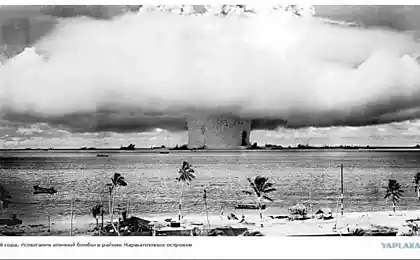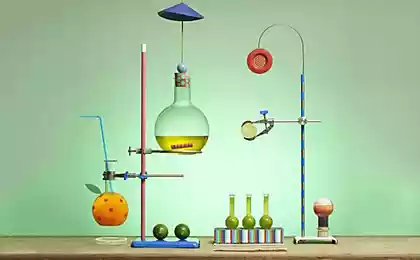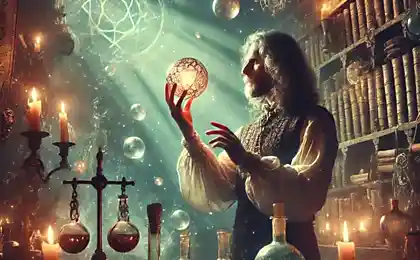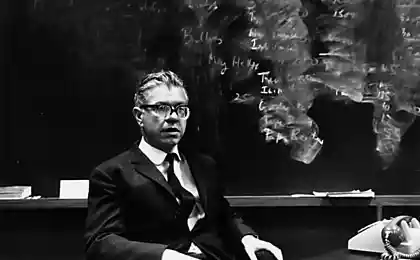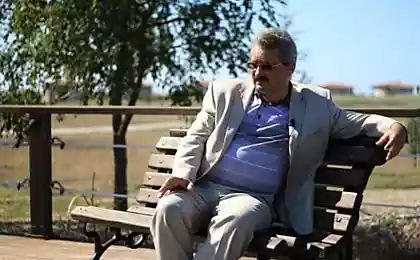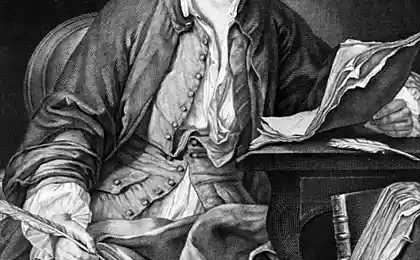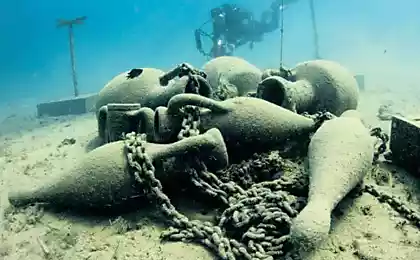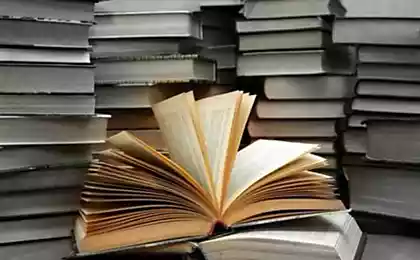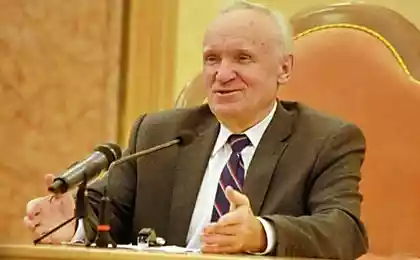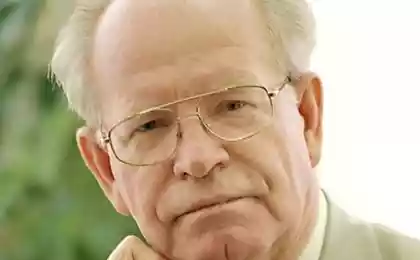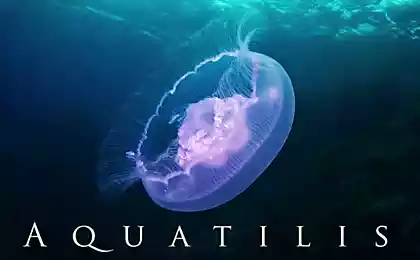733
10 most bizarre experiences in the history of science
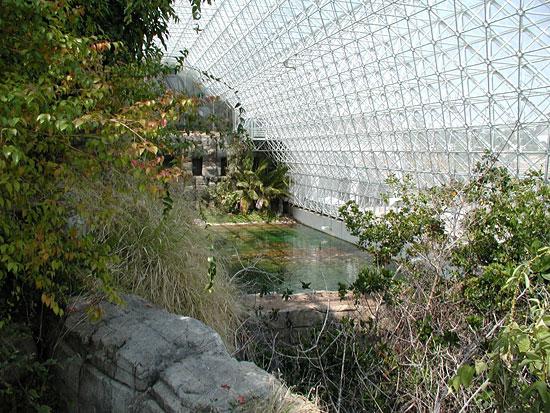
History is full of natural science experiments deserve the name of the country. Described below ten selected entirely on the taste of the author, with whom you can not agree. Some of the experiments, caught in this collection, came to nothing. Others have led to new branches of science. There are experiments that started many years ago, but not finished until now.
1. Jumping NyutonaV child Isaac Newton (1643-1727) grew up quite frail and sickly boy. In games in the fresh air it usually lagged behind their peers.
Third he died in September 1658, Oliver Cromwell, English revolutionary, briefly became the sovereign ruler of the country. On this day over England swept unusually strong winds. People say it's the devil flew for the soul of the usurper! But in the town of Grantham, where at that time lived Newton, the children started racing in long jump. Noting that better jump on the wind than against him, Isaac outstripped all rivals. Later, he began experiments: written, how many feet manage to jump on the wind, how much - against the wind and on what distance he can jump on a windless day. So he got the idea of the strength of the wind, expressed in feet. Already a well-known scientist, he said that he believes these jumps their first experiments.
Newton is known as a great physicist, but his first experiment can be attributed more to meteorology.
2. Concert relsahByl and the reverse case: meteorologist conducted an experiment to prove the validity of one physical hypothesis.
Austrian physicist Christian Doppler in 1842 and put forward a theoretical basis for the assumption that the frequency of light and sound vibrations should be changed to the observer depending on whether the light source is moving or the sound of an observer or for him.
In 1845, Dutch meteorologist Christopher Buys-Ballot decided to test the hypothesis Doppler. He hired a locomotive with a cargo platform, planted on a platform of two trumpet players and asked them to keep a note of salt (two trumpeters were needed to ensure that one of them could gain air, while the other pulls the note, and so the sound is not interrupted). On the platform of the little station between Utrecht and Amsterdam meteorologist posted several musicians with no tools, but with an absolute ear for music. After that the locomotive became different rates to drag the platform with trumpeters by the platform with the audience, and they pointed out what note is heard. Then observers forced to ride, and the trumpeters played, standing on the platform. The experiment lasted two days, as a result, it became clear that the Doppler rights.
By the way, later Buys Ballot-founded the Dutch weather service, formulated the law in his own name (if in the Northern Hemisphere to become back to the wind, the area of low pressure will be on you on the left hand) and became a foreign corresponding member of the St. Petersburg Academy of Sciences.
3. Science, born over a cup chayaOdin of the founders of biometrics (mathematical statistics for processing results of biological experiments) English botanist Robert Fischer worked in the years 1910-1914 in the agro-biological station near London.
The team consisted of employees of some men, but once on the job took a woman, a specialist in algae. For it has been decided to establish a common room on the Fife-shreds. At the first tea party has gone to the eternal dispute on the subject of England: that the right - add milk to tea or pour tea into a cup, which already have milk? Some skeptics began to say that the same proportion is no difference in the taste of the drink will not be, but Muriel Bristol, a new employee, alleged that easy to distinguish the "wrong" tea (English aristocrats think is correct refill milk tea, and not vice versa).
In the next room was prepared with the assistance of a staff chemist in many ways a few cups of tea, and Lady Muriel showed the subtlety of its taste. And Fischer wondered how many times it is necessary to repeat the experience, so that the result can be considered reliable? After all, if the cups have been only two, guess the method of preparation they could have by accident. If three or four - accident also could play a role ...
From these reflections born classic book "Statistical methods for research workers," published in 1925. Fischer biologists and physicians have used until now.
Note that Muriel Bristol, according to the memoirs of one of the participants of the tea party, correctly identified all the cups.
By the way, the reason why the English high society decided to top up the milk in tea, and not vice versa, is related to the physical phenomenon. Know always drank tea from porcelain, which can explode if you first pour in a cup of cold milk, then add hot tea. Simple Englishmen drank tea from porcelain and pewter mugs, without fearing for their integrity.
4. Home Mowgli 1931 conducted an unusual experiment family of American biologists - and Winthrop Kellogg Lyuella. After reading an article about the sad fate of the children that grew among the animals - wolves or monkeys, biologists thought: what if to do the opposite - to try to bring up the monkey cub in the human family? Not whether he will approach to the man? First, scientists would like to move with his young son Donald to Sumatra, where it was easy to find among orangutans companion for Donald, but it did not have enough money. However, Yale Center for the Study of apes lent them a little female chimpanzee who was called Gua. She was seven months and Donald - 10.
Spouses Kellogg know that almost 20 years before their experiment Russian researcher Nadezhda Ladygina already tried to bring, how to raise children, shimpanzёnka year-old and three years have not made progress in the "humanization". But Ladygina experiments were conducted without the participation of children and Kelloggs hoped that the joint training with their son will give different results. Besides, it was impossible to rule out that one year of age is already too late for the "re-education».
Gua took the family and began to raise a par with Donald. They liked each other and soon became inseparable. Experimenters recorded every detail: Donald like the smell of perfume, Gua does not like him. Conducted experiments: who quickly guess how to use a stick to get cookies, suspended from the ceiling of the room on a string? And if you strike up a boy and the monkey's eyes and call them by name, who better to determine the direction from which the sound comes? In both tests, he won Gua. But when Donald was given a pencil and paper, he started something karyabat on the sheet, and the monkey had to learn what you can do with a pencil.
Attempts to bring the ape to man under the influence education have appeared rather unsuccessful. Although Gua often moved on two legs and learned to eat with a spoon, even became a little bit to understand human speech, it become confused when familiar people appeared in different clothing, it could not be taught to utter a single word - "Dad" and she, unlike by Donald, could not master the simple game like our "ladushek».
However, the experiment had to be aborted when it became clear that to 19 months and Donald did not shine eloquence - he has mastered all three words. And worse yet, the desire to eat, he began to express a typical monkey sounds like vzlaivaniya. Parents were afraid that the boy gradually falls down on all fours, and human language has not mastered. And Gua sent back to the nursery.
5. DaltonaRech eyes will focus on experiments conducted at the request of the experimenter after his death.
English scientist John Dalton (1766-1844) remembered us mainly for its discoveries in physics and chemistry, as well as the first description of a congenital lack of view - color blindness, in which the broken color recognition.
Sam Dalton noted that suffer from this drawback, only after how in 1790, became interested in botany and found it difficult to understand the botanical monographs and determinants. When the text dealt with the white or yellow flowers, he felt no difficulty, but if the flowers are described as purple, pink or dark red, they all seemed indistinguishable Dalton from the blue. Often, identifying the plant, as described in the book, scientists had to ask somebody: it is blue or pink flower? Surrounding thought he was joking. Dalton knew only his brother, who had the same hereditary defect.
Sam Dalton, comparing their color perception with a vision of flowers friends and acquaintances, decided that in his eyes there is some kind of a blue filter. And bequeathed to his laboratory assistant after his death to extract his eyes and check to see if painted in a bluish color of the so-called vitreous humor - jelly mass that fills the eyeball?
Laboratory scientist, and fulfilled the will not find in his eyes, nothing special. He suggested that Dalton may have been something wrong with the optic nerves.
Dalton's eyes were kept in Bank of alcohol in the Manchester Literary and Philosophical Society, and in our time, in 1995, geneticists identified and examined the DNA of the retina. As expected, it showed the genes of color blindness.
Not to mention two more very strange experience with the bodies of humans. Isaac Newton, carved from ivory thin curved probe, launched it in his eyes and pressed them to the rear side of the eyeball. In the eyes there and flash colored circles, from which the great physicist came to the conclusion that we are seeing around the world because the light is putting pressure on the retina. In 1928, one of the pioneers of television, the English inventor John Baird, trying to use the human eye as a transmission chamber, but, of course, failed.
6. Is the Earth - the ball? A rare example of an experiment in geography, which in fact is not an experimental science.
Outstanding English evolutionary biologist, associate Darwin - Alfred Russel Wallace was an active fighter against pseudoscience and every superstition.
In January 1870 Wallace read in a scientific journal ad submitter that offer dispute to £ 500 to anyone who will undertake clearly prove the sphericity of the Earth and "demonstrate a manner understandable to every sensible person, convex railway, river, canal or lake." The debate offered a John Hamden, the author proves that the Earth is in fact - a flat disk.
Wallace decided to accept the challenge and to demonstrate the rounded Earth chose rectilinear segment of the channel length of six miles. At the beginning and end of the segment were two bridges. On one of them, Wallace set horizontally 50 times the telescope with reticle in the eyepiece thread. In the middle of the channel at a distance of three miles from each bridge, he set high poles with a black circle on it. In another bridge hung a board with a horizontal black stripe. Height above the water telescope, black circle and black strip was exactly the same.
If the Earth (and the water in the channel) is flat black stripe and black circle should match in the eyepiece of the telescope. If the convex surface of the water, repeating the bulge of the Earth, the black circle has to be above the band. And so it happened. And the size of the discrepancy is in good agreement with the calculated output from the known radius of the planet.
However, Hamden refused even to look through a telescope, by sending it to his secretary. A secretary assured the audience that the two marks are level. If a discrepancy is observed, then this is due to the aberrations of the telescope lenses.
There followed years of litigation, which resulted in Hamden still forced to pay 500 pounds, but Wallace spent on legal costs considerably more.
7 and 8 of the two longest eksperimentaVozmozhno, the longest experiment the world began 130 years ago (see. "Science and Life» № 7, 2001) and is not yet finished. American botanist WJ. Bil in 1879 buried in the ground with 20 bottles seeds of common weeds. Since then, periodically (every first five, then ten, and still later - every twenty years), scientists dig one bottle and test seeds germination. Some particularly resistant weeds germinate until now. The next bottle should get in the spring of 2020.
The longest physical experiment began in the Australian city of Brisbane University Professor Thomas Parnell. In 1927, he placed in the fortified glass on a tripod funnel piece solid resin - Vara, who is on the molecular properties liquid, although it is very viscous. Parnell then heated funnel to pitch slightly melted and zatёk in the spout of the funnel. In 1938, the first drop of resin dropped in the substituted Parnell beaker. The second fell in 1947. In autumn 1948 Professor died, and continued monitoring of the funnel his disciples. Since the drops fell in 1954, 1962, 1970, 1979, 1988 and 2000. The frequency of falling drops in recent decades has slowed down due to the fact that in the laboratory mounted air conditioner and it was colder. Curiously, I never drop does not fall in the presence of any of the observers. Even when in 2000 before the funnel mounted webcam to transmit images to the Internet, at the time of the fall of the eighth and the last drop of the camera today denied!
The experience is far from complete, but it is clear that the pitch in a hundred million times more viscous than water.
9. Biosphere 2This the biggest experiment of got in our arbitrary list. It was decided to make a working model of the terrestrial biosphere.
In 1985, more than two hundred American scientists and engineers came together to build in the Sonoran Desert (Arizona), a huge glass building with samples of the earth's flora and fauna. We planned to seal the building from any income foreign matter and energy (except the energy of sunlight), and settled there for two years a team of eight volunteers, who immediately nicknamed "bionavtami." The experiment was supposed to contribute to the study of the relationships in the natural biosphere and check the possibility of continued existence people in a closed system, such as long-distance space flights. Supply oxygen must have been a plant; Water, as expected, will be provided natural cycle and processes of biological self-cleaning, food - Plants and animals.
The internal area of the building (1, 3 ha) was divided into three main parts. The first samples were housed five characteristic of the Earth's ecosystems: tropical forest land, "Ocean" (pool with salt water), desert, savanna (from flowing through it, "the river") and the swamp. All these parts have lodged selected botany and zoology of flora and fauna. The second part of the building was taken life-support systems: a quarter of a hectare for growing edible plants (139 species, excluding tropical fruit of the "forest"), pools for fish (tilapia taken as unpretentious, tasty and fast growing species) and cut biological wastewater treatment. Finally, there were the residential compartments "bionavtov" (each - 33 square meters with a common dining room and living room). Solar panels provide electricity for computers and lighting the night.
At the end of September 1991 eight people "immured" in a glass greenhouse. And soon the problems started. The weather turned out to be unusually cloudy and photosynthesis was going weaker standards. In addition, soil bacteria have multiplied, consume oxygen, and 16 months of its content in the air decreased with the normal 21% to 14%. It was necessary to add oxygen from outside, from cylinders. Yields of edible plants were lower than calculated, the population of "Biosphere 2" constantly starving (although in November it was necessary to open a grocery NC, two years of experience the average weight loss was 13%). Gone populated pollinating insects (generally died out 15 to 30% of the species), but multiplied the cockroaches, which no one inhabits. "Bionavty" yet somehow managed to sit in prison planned for two years, but on the whole experiment was unsuccessful. However, he once again showed how thin and vulnerable to the mechanisms of the biosphere, providing our lives.
Giant structures now used for the individual experiments with animals and plants.
10. Burning almazaV Nowadays no one is surprised experiences expensive and requires a great deal of experimental setups. However, 250 years ago it was a novelty, so look at the amazing experience of the great French chemist Antoine Lavoisier converged crowds (especially since the tests took place in the open air, in the garden near the Louvre).
Lavoisier studied the behavior of various materials at high temperatures, which built a huge installation with two lenses to concentrate the sunlight.
Source: www.nkj.ru
via factroom.ru
Rumbling in the abdomen called scientific "borbo-rygmus»
Outshoot - photoblog from the creators Faktruma


